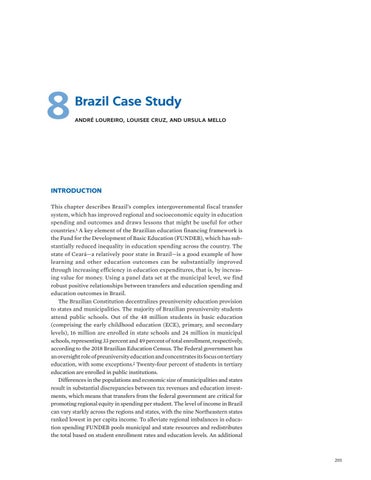8
Brazil Case Study ANDRÉ LOUREIRO, LOUISEE CRUZ, AND URSULA MELLO
INTRODUCTION This chapter describes Brazil’s complex intergovernmental fiscal transfer system, which has improved regional and socioeconomic equity in education spending and outcomes and draws lessons that might be useful for other countries.1 A key element of the Brazilian education financing framework is the Fund for the Development of Basic Education (FUNDEB), which has substantially reduced inequality in education spending across the country. The state of Ceará—a relatively poor state in Brazil—is a good example of how learning and other education outcomes can be substantially improved through increasing efficiency in education expenditures, that is, by increasing value for money. Using a panel data set at the municipal level, we find robust positive relationships between transfers and education spending and education outcomes in Brazil. The Brazilian Constitution decentralizes preuniversity education provision to states and municipalities. The majority of Brazilian preuniversity students attend public schools. Out of the 48 million students in basic education (comprising the early childhood education (ECE), primary, and secondary levels), 16 million are enrolled in state schools and 24 million in municipal schools, representing 33 percent and 49 percent of total enrollment, respectively, according to the 2018 Brazilian Education Census. The Federal government has an oversight role of preuniversity education and concentrates its focus on tertiary education, with some exceptions.2 Twenty-four percent of students in tertiary education are enrolled in public institutions. Differences in the populations and economic size of municipalities and states result in substantial discrepancies between tax revenues and education investments, which means that transfers from the federal government are critical for promoting regional equity in spending per student. The level of income in Brazil can vary starkly across the regions and states, with the nine Northeastern states ranked lowest in per capita income. To alleviate regional imbalances in education spending FUNDEB pools municipal and state resources and redistributes the total based on student enrollment rates and education levels. An additional
201






